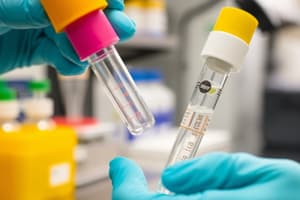Podcast
Questions and Answers
Match the following with their respective functions in the seismic inversion workflow:
Match the following with their respective functions in the seismic inversion workflow:
Inversion Calibration = Fine-tuning inversion parameters Inversion Analysis = Examining target zone before full inversion Inversion Type Selection = Selecting type of inversion to run Wavelet Scaling = Adjusting wavelet for inversion process
Match the following with their descriptions in the seismic inversion process:
Match the following with their descriptions in the seismic inversion process:
Data Accuracy vs. Model Smoothness = Achieving desired balance in inversion process Parameters Tuning = Adjusting set of parameters based on inversion type and software Misfit Function = Extra function affecting balance of all parameters Seismic Variability = Related to lateral and vertical variability of the solution
Match the following tasks with their roles in the seismic inversion workflow:
Match the following tasks with their roles in the seismic inversion workflow:
Reviewing Inversion Parameter Testing = Ensuring accuracy of parameter testing Exploring Quality Control of Results = Checking reliability of subsurface models Using Inversion Results for Interpretation = Applying results to porosity and facies interpretation Calibrating Inversion Parameters = Fine-tuning parameters before full inversion
Match the following with their importance in the seismic inversion process:
Match the following with their importance in the seismic inversion process:
Match the seismic inversion challenge with its description:
Match the seismic inversion challenge with its description:
Match the solution for addressing seismic inversion challenges with their description:
Match the solution for addressing seismic inversion challenges with their description:
Match the summary statement with its implication for inversion studies:
Match the summary statement with its implication for inversion studies:
Match the following QC methods with their descriptions:
Match the following QC methods with their descriptions:
Match the following analysis objectives with their corresponding outputs:
Match the following analysis objectives with their corresponding outputs:
Match the following discriminating parameters with their respective lithologies:
Match the following discriminating parameters with their respective lithologies:
Match the following visualization tools with their applications:
Match the following visualization tools with their applications:
Match the following terms with their correct definitions:
Match the following terms with their correct definitions:
Match the following statements with the correct type of data to be checked in inversion quality control:
Match the following statements with the correct type of data to be checked in inversion quality control:
Match the following tasks with their descriptions in the seismic inversion workflow:
Match the following tasks with their descriptions in the seismic inversion workflow:
Match the following tools with their purpose in controlling parameter changes:
Match the following tools with their purpose in controlling parameter changes:
Match the following characteristics with their implications on inversion quality control:
Match the following characteristics with their implications on inversion quality control:
Match the following data attributes with their role in final inversion quality control:
Match the following data attributes with their role in final inversion quality control:
Match the following visual representations with their purpose in Residual QC:
Match the following visual representations with their purpose in Residual QC:
Match the following issues with their implications on Residual QC:
Match the following issues with their implications on Residual QC:
Match the following types of assessments with their descriptions:
Match the following types of assessments with their descriptions:
Match the following terms with their correct descriptions:
Match the following terms with their correct descriptions:
Flashcards are hidden until you start studying




